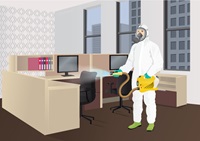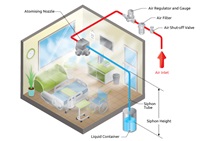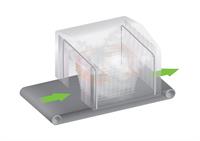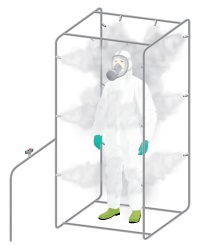Spray nozzles for disinfecting
The use of liquid disinfectant to combat the spread of pathogens is a common application for spray nozzles. There are many types of sanitising systems used to combat pathogens. Depending on the type of pathogen and the environment different
types of spray nozzle will be required. 
*For a detailed exploration of the specifics of disinfectant spraying for Covid19 please click and download the technical article linked here.
For our full Cleaning & Disinfection Brochure, see the Brochure icon on the right.
Broadly speaking, three distinct types of disinfection spray system can be defined:
1. Mobile spraying/fogging. With these systems the nozzle is brought close to the area or surface being treated. The applicator device is then moved around to ensure the entire area is treated. 2. Point spraying/fogging. With this system a sanitising fog is delivered from single or multiple stationary points. This could be from permanently installed spraying systems or from a mobile unit deployed in a room and left
to fill it with fog. The BETE FastPASS™ is another type of fixed point spraying system. Nozzles are fixed inside the cabins of buses and an external cart with compressed air supply delivers the disinfectant to the nozzles
which emit a fine fog that disinfects the bus in 3-5 minutes without the operator having any exposure to disinfecting chemicals. 3. Sanitising spray chambers. With this system the object being sanitised is placed in a spray chamber to be treated or rolls through a sanitising spray station on a conveyor. The sanitising spray is confined to a small area
with multiple targets being brought to the spray rather than the spray being brought to them. Each of the three types of sanitising application will require different types of sprays/fogs and so have differing spray nozzle requirements Clearly, they will also have very different fluid supply systems as well. Understanding
what these differences are and which spray nozzles to use is vital for effective system design.
| 
1 -Mobile spraying 
2 -Point Spraying/ fogging 
3 -Santising spray chamber |
Overall objectives
There are two overall objectives in any sanitising application. This is common to all three broad types of system mentioned above. The first is to effectively coat all parts of the surface with enough disinfectant liquid to kill the pathogens
that may be present. The second is to ensure that any pathogens in the air space also come into contact with enough disinfectant to eliminate them.
Surface treatment

In order to ensure that good disinfection occurs, the ideal spray scenario is to give an even coating to all contaminated surfaces. Often the amount of disinfectant required to eliminate pathogens is quite low. This is particularly true for
viruses. So, a small micro-coating of liquid will often suffice. It is also highly beneficial to use low volumes of disinfectant to form micro-coatings for reasons of cost and because larger applications of fluid may cause wetting or other
damage.
Getting a fluid to move evenly over a surface and adhere to it can be problematic for larger-scale disinfection. With conveyor or spray chamber systems this problem is solved by concentrating the spray in a small area and bringing the targets through
the spray. An example would be a conveyor that disinfects commonly used objects such as shopping trollies or a spray tunnel for the disinfection of people and PPE. With these systems short-range misting nozzles will suffice.
Large areas
When it comes to disinfecting rooms, we cannot use a conveyor type system so other nozzle systems will be required. As well as the larger scale of the spraying operation there is an additional problem in that many of the surfaces that need to be
treated are not the in direct line of sight of the spray nozzles being deployed. This can be overcome by having a mobile system that is moved around by an operator, but this might not be feasible in many situations.
In order to achieve good contact with every surface in a room we need to generate a fog that will permeate the entire area. If we can get a droplet size small enough, the resulting spray/fog will be carried around on air currents so that it reaches
all parts of the room. In order to achieve a good fog suitable for these purposes we need to get an average droplet size below 30 microns.
To aid with fluid distribution fans can be used to disperse the fog more rapidly. Alternatively, air atomising nozzles can be used as these often have long spray projections from the nozzle.
Further details
For a more detailed discussion of droplet size, reach, and wetting please consult the sub-pages accessible in the blue menu to the right of this main page. To access data on individual spray nozzles please click on the nozzle boxes for spray nozzle datasheets.
Nozzles
For more details on how the nozzle types below can be successfully deployed in sanitising applications please click on the items in the grey menu to the right. Datasheets on each product can be accessed by clicking on the nozzle boxes below.